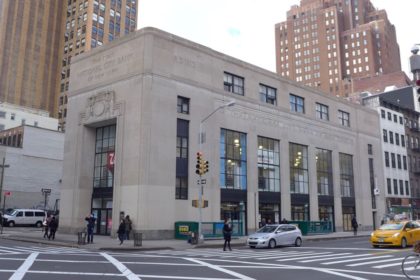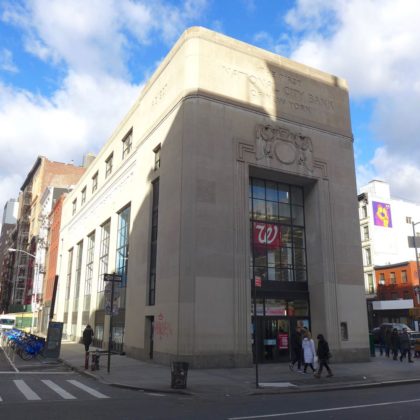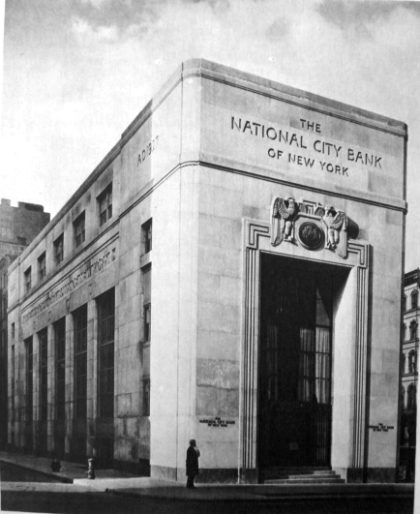The History of 415 Broadway
 Tom Miller, who writes about the history of Manhattan buildings at Daytonian in Manhattan, has allowed Tribeca Citizen to create a database of his Tribeca posts. If you enjoy these, and you will, then you should definitely check out his website, which also has write-ups about buildings all over the island. And don’t miss his book, Seeking New York: The Stories Behind the Historic Architecture of Manhattan—One Building at a Time.
Tom Miller, who writes about the history of Manhattan buildings at Daytonian in Manhattan, has allowed Tribeca Citizen to create a database of his Tribeca posts. If you enjoy these, and you will, then you should definitely check out his website, which also has write-ups about buildings all over the island. And don’t miss his book, Seeking New York: The Stories Behind the Historic Architecture of Manhattan—One Building at a Time.
··································
 As early as 1856, the Cozzens brothers, John and Sylvanus, ran a hotel sat on the odd little sliver of real estate between Broadway, Canal Street, and Lispenard Street. As the century wore on, it became the sleazy Brandreth Hotel made infamous by its drug-dealing proprietor and at least one murder.
As early as 1856, the Cozzens brothers, John and Sylvanus, ran a hotel sat on the odd little sliver of real estate between Broadway, Canal Street, and Lispenard Street. As the century wore on, it became the sleazy Brandreth Hotel made infamous by its drug-dealing proprietor and at least one murder.
The Broadway-and-Canal-Street neighborhood changed dramatically in the latter part of the 19th century, with elaborate cast iron or stone retail and office buildings rapidly being built. By the turn of the century the hotel was gone, replaced by the Brandreth Building, an “office and studio” building that was home to firms like the Hensel-Colladay Company that sold “dress, millinery and upholstery trimmings.”
In 1917 the Columbia Bank opened a branch office here, to be replaced a decade later by the First National City Bank of New York. The bank was founded as the City Bank of New York in 1812, changing its name when it joined the national banking system in 1863. The bank grew rapidly and after World War I was expanding with new branches and in October, 1926, bought the Columbia Bank’s plot of land.
Architects Walker & Gillette were chosen to design the new building. Although the firm had become well-known for its neo-classical style buildings; with the coming of the Jazz Age it embraced something new: Art Deco. For the long, narrow plot Walker & Gillette designed an Art Moderne stone block with a soaring banking area and offices above. The monumental entrance on Broadway was capped by idealized sculptures of side-viewed eagles flanking the bank’s inset seal. Completed in 1927, the bank’s streamlined, clean lines were in stark contrast to the busy cast iron Victorian structures that surrounded it. Architectural critic for The New Yorker, Lewis Mumford, approved saying, “The note of modernism pervades this structure… and is splendidly successful.”
 The bank president at the time was Charles E. Mitchell and two years later he would be made chairman. National City Bank of New York was growing at an blurring pace with branches in nearly two dozen foreign countries. In 1929, it had become the largest commercial bank in the world. Not all was rosy, however. Mitchell’s aggressive and, some would say, questionable policies are blamed by historical economists as major influences in the stock market crash of 1929, leading to the Great Depression. In 1933, the Pecora Commission was formed; a Senate committee set up to investigate Mitchell. Committee member Senator Carter Glass reported that “Mitchell, more than any 50 men is responsible for this stock crash.”
The bank president at the time was Charles E. Mitchell and two years later he would be made chairman. National City Bank of New York was growing at an blurring pace with branches in nearly two dozen foreign countries. In 1929, it had become the largest commercial bank in the world. Not all was rosy, however. Mitchell’s aggressive and, some would say, questionable policies are blamed by historical economists as major influences in the stock market crash of 1929, leading to the Great Depression. In 1933, the Pecora Commission was formed; a Senate committee set up to investigate Mitchell. Committee member Senator Carter Glass reported that “Mitchell, more than any 50 men is responsible for this stock crash.”
 The building shortly after construction.
The building shortly after construction.
··································
The Depression eventually passed and the sleek bank building at 415 Broadway remained a fixture at Broadway and Canal Street. The bank changed its name again in 1955 to The First National City Bank of New York, then to First National City Bank in 1962, and finally in 1976 to Citibank, N.A.
Citibank moved out of its eye-catching building in the 1990s. Esteemed restoration architect Joseph Pell Lombardi, known for his work with numerous Manhattan vintage structures, remodeled the building for retail use. Although the streamlined interior details are gone—the polished stone teller counters and the zig-zag decorated cages—the wonderful Art Modern facade of Walker & Gillette is, for the most part, intact.
··································
Photo credits from top: Tribeca Citizen (2); from the collection of Daytonian in Manhattan.












